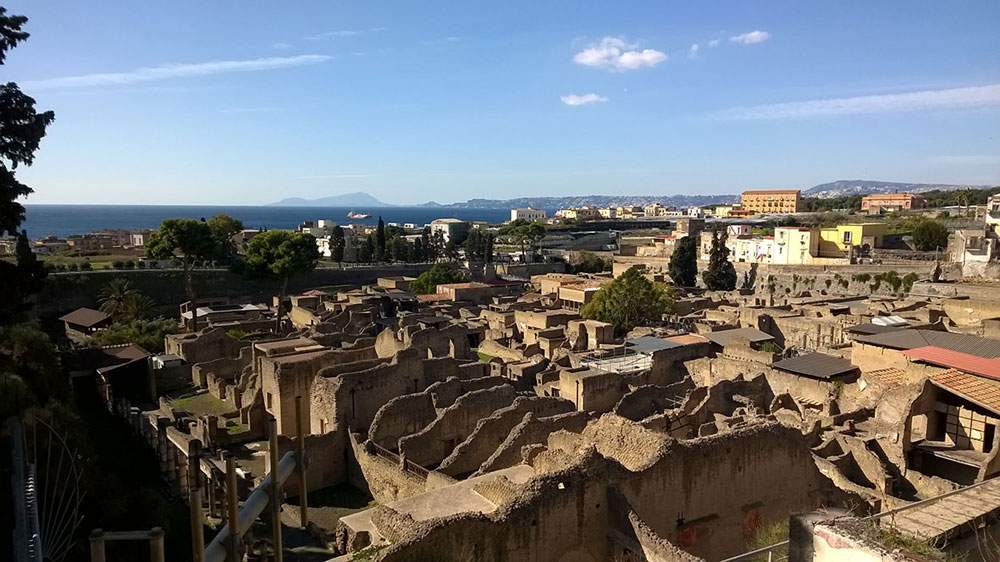A new study published in the American scientific journal PLOS ONE reveals an extraordinary discovery: human neurons in the brain of a victim of the eruption that buried Herculaneum, Pompeii and the entire Vesuvian area in 79 AD.
The exceptional discovery was made by forensic anthropologist Pier Paolo Petrone, head of the Laboratory of Human Osteobiology and Forensic Anthropology at the Departmental Section of Forensic Medicine at the University of Naples Federico II, in collaboration with geologists, archaeologists, biologists, forensic scientists, neurogeneticists and mathematicians from national universities and research centers.
“The discovery of brain tissue in ancient human remains is an unusual event,” said Petrone, “but what is extremely rare is the integral preservation of neuronal structures of a 2,000-year-old central nervous system, in our case at an unprecedented resolution.”
The eruption, which caused the devastation of the Vesuvian area and the death of thousands of inhabitants, burying the city of Herculaneum in a few hours allowed the preservation of biological remains, including human ones. “The extraordinary discovery was able to rely on the most advanced and innovative electron microscopy techniques of the Department of Science at the University of Roma Tre, an Italian excellence,” added Guido Giordano, professor of Volcanology at the Department of Science of the Roman Athenaeum, “where the perfectly preserved neuronal structures were made possible thanks to the conversion of human tissue into glass, which gives clear indications of the rapid cooling of the scorching volcanic ash that hit Herculaneum in the early stages of the eruption.”
“The results of our study show that the unique eruption-induced vitrification process ”froze“ the cellular structures of this victim’s central nervous system, preserving them intact to this day,” Petrone further commented.
The investigation of the eruption victims is continuing with collaboration between the various fields of research. “The fusion of the knowledge of the forensic anthropologist and the medico-legal scientist are yielding unique information that would otherwise be unobtainable,” said Massimo Niola, professor and director of the U.O.C. of Forensic Medicine at Federico II.
The study also analyzed data on some proteins already identified by researchers in a paper published last January in the New England Journal of Medicine. “A major aspect could concern the expression of genes encoding proteins isolated from vitrified human brain tissue,” explained Giuseppe Castaldo, Principal Investigator of CEINGE and professor of Technical Sciences of Laboratory Medicine at the Federico II. “All the gene transcripts we identified are present in the various districts of the brain such as, for example, the cerebral cortex, cerebellum or hypothalamus,” said Maria Pia Miano, neurogeneticist at the CNR Institute of Genetics and Biophysics in Naples.
But investigations into the remains of the eruption victims continue. The Archaeological Park of Herculaneum has included bioanthropological and volcanological investigations among the research topics to be given priority because of the exceptional interest they can have not only in the scientific sphere, but also in the field of historical studies and strengthening the capacity to deal with catastrophes such as the eruption of Vesuvius in 79 AD. “The extraordinary results obtained,” concluded Francesco Sirano, Director of the Archaeological Park of Herculaneum, “demonstrate the importance of the multidisciplinary studies conducted by researchers at the Federico II University and the uniqueness of this extraordinary site, once again in the international limelight with its priceless heritage of treasures and archaeological discoveries.”
The ongoing research goes in the direction of backward reconstruction of the various phases of the eruption, assessing the timing of exposure to high temperatures and cooling of the flows, which have importance not only for archaeology and bioanthropology, but also for volcanic risk.
The study was conducted in collaboration with the Herculaneum Archaeological Park by researchers from the Federico II University, CEINGE-Advanced Biotechnology, the Universities of Roma Tre and Statale di Milano, and the CNR
 |
| Extraordinary discovery at Herculaneum: human neurons from an eruption victim |
Warning: the translation into English of the original Italian article was created using automatic tools. We undertake to review all articles, but we do not guarantee the total absence of inaccuracies in the translation due to the program. You can find the original by clicking on the ITA button. If you find any mistake,please contact us.